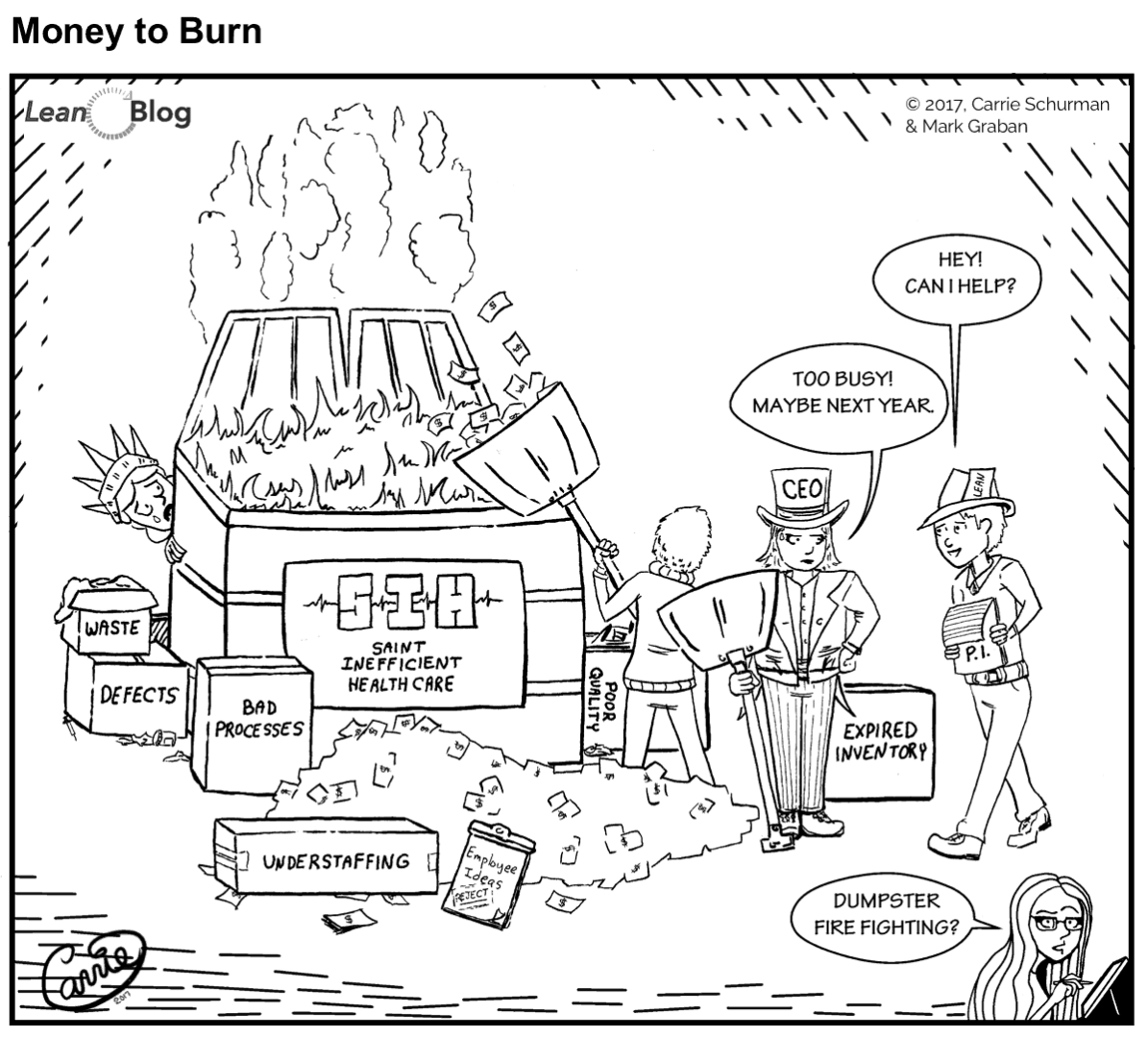In recent months, I've heard of the following things being said or happening, either directly or indirectly, at many organizations in American healthcare:
“We don't have the budget to start that continuous improvement initiative right now, but maybe in six months.”
Or I've heard, basically, the complete opposite (and more rare) sentiment from a different health system:
“Our leadership doesn't see a need for Lean because our margins are over 10% and things are fine.”
I've also heard about hospitals decimating their internal Lean group / department or laying some people off in the name of saving money (or some combination of new leadership and a change in strategic direction).
Does “we don't have the budget” really just mean “we don't want to do this right now” or “we don't think we really need to do this right now?” It might be an extension of the old tongue-in-check expression from General Motors that said, “We'll save money… no matter how much it costs us!”
I get especially frustrated when I hear of hospitals thinking Lean is only about bottom line margin reduction. If their margin is acceptable, is that because quality, patient safety, and other important factors are significantly better than the typical hospital? Probably not… it's more likely due to local market power or forces other than operational excellence.
All of this led to my latest cartoon collaboration with Carrie Schurman (see all of them)… and not because they have any of those problems at her health system.
This cartoon is a parody of a parody. It's done in the style of the “Stan Kelly” editorial cartoons from “The Onion,” the famed parody news publication. You can read this article about the brilliance of the Stan Kelly cartoons. Carrie shows her artistic versatility in mimicking that style, at my suggestion.
This cartoon is our homage to this style and we think it covers a very important topic in healthcare.
Elements that are parodied from the Stan Kelly cartoons, if you're not familiar with them:
- The crying Statue of Liberty (it's in every Stan Kelly cartoon)
- The cartoonist drawing themselves in the lower right cartoon making a pun or snide remark
- The metaphors being very unsubtly labeled, like the boxes, the piles of money and rejected employee ideas, the CEO dressed as an old-time tycoon, and the Process Improvement person looking like a young, earnest reporter (with a clipboard that says “P.I.” and a hat tag that says “Lean” instead of “PRESS.”
Back to the content of the cartoon… it's always bothered me when hospitals say something like, “We don't have the budget for continuous improvement” (or Lean).
For one, improvement work should have a pretty direct impact on the bottom line. The problem is that some of the costs might be known and immediate, while the benefits are projected for the future. Shouldn't we invest a little bit of staff time now for a big payoff in terms of quality and productivity a little way's down the road?
We shouldn't ONLY focus on cost-cutting (as that's not what Lean's about, as I've written about before):
Where Do Hospitals Get the Idea that Lean is Only About Cost Reduction?
We shouldn't necessarily focus primarily on cost cutting… but rather view cost reduction as the end result of improving other things that matter, such as:
- Patient Safety
- Employee Safety
- Quality and Outcomes
- Waiting Times and Access
- Employee Engagement and Morale
Hospitals claim they don't have money for improvement. But they DO have money to burn as the result of the poor processes and systems that they aren't improving through Lean and related methods?
That's crazy, isn't it?
Hospitals don't have money for #Lean, but they're apparently happy to shovel money into a burning dumpster every day. Click To TweetI've often used the expression that “hospitals don't have money for Lean, but they're apparently happy to shovel money into a burning dumpster every day.” This cartoon visualizes that. Harsh, I realize.
If you believe the estimates from Don Berwick and others that say 30% of our nation's healthcare spending is “waste” (and a lot of it is driven by inefficient processes and poor quality), who has time to delay improvement? How is not improving an effective strategy? Not improving wastes money… patients get hurt in the process. The current state of a hospital is often a real mess (hence the dumpster fire analogy).
Dr. Atul Gawande's Article on Reducing the Waste of Unnecessary Healthcare
It reminds me of the recent meme I created around the idea of not having time for improvement… but having time for continual, repeated “fire fighting.”
Anyway, if we can't change these mindsets… I hope you at least enjoy the cartoon.
What do you think? Please scroll down (or click) to post a comment. Or please share the post with your thoughts on LinkedIn – and follow me or connect with me there.
Did you like this post? Make sure you don't miss a post or podcast — Subscribe to get notified about posts via email daily or weekly.
Check out my latest book, The Mistakes That Make Us: Cultivating a Culture of Learning and Innovation:










I saw a comment on Twitter about this cartoon and “fire fighting.”
This doesn’t illustrate fire fighting at all. More like pouring gasoline onto the fire with continued poor performance and bad results… and being too busy to improve.